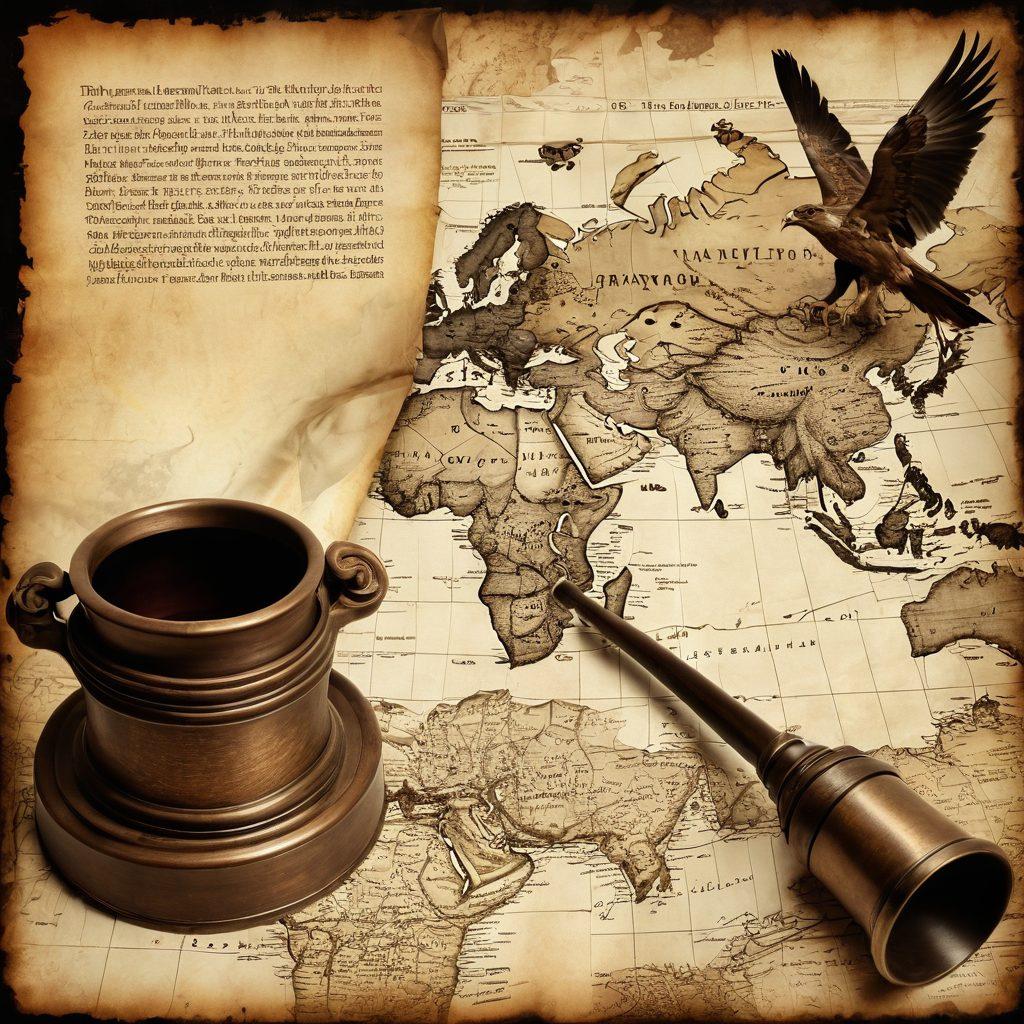Unraveling the Past: A Guide to Blogging About Historical Events and Narratives
In a world where information is just a click away, the allure of historical events can often take a backseat to the flashy news of today. However, as budding bloggers and history enthusiasts, we have the unique opportunity to turn back the clock and craft captivating chronicles that not only engage but educate our audience. Imagine your readers captivated by a story from the past, one that resonates with their present, and one that they feel compelled to share. How can we achieve this? The secret lies in weaving together engaging narratives that breathe life into the rich tapestry of history.
Crafting these captivating chronicles starts with understanding your audience's needs and interests. Are they curious about local history or perhaps broader cultural studies? Once you pinpoint these interests, dive deep into your historical research. Seek out primary sources and timelines that lend authenticity to your writing. Then, combine those historical events with relatable storytelling. Just like a well-spun tale, your blog posts should evoke emotions, paint vivid imagery, and offer insightful articles that make readers feel as if they are living the moments you're describing.
One cannot underestimate the power of an engaging narrative. Remember the quote, "History is written by the victors," but in our blogs, we must aim to present a balanced view, incorporating perspectives of different groups. As you embrace informative writing, consider how you can make history relevant to today’s digital world. Perhaps you draw parallels between a historical event and current social issues, or you invite your readers to explore lesser-known narratives that deserve a spotlight. Such approaches not only inform but also spark meaningful discussions within your interactive community.
As you delve deeper into your academic writing, you’ll find that incorporating educational articles on historical documentation enhances your credibility as a writer. Being transparent with your sources and showcasing your fact-based articles will not only build trust with your readers but also provide them with the tools to explore further. Encourage them to engage with their own historical research by offering writing resources tailored to their interests and needs, making your blog a nurturing ground for budding historians.
Finally, remember that digital history is about more than just crafting hypotheses; it’s about creating a narrative that is enjoyed and embraced. Engage your readers by asking thought-provoking questions: How does our understanding of the past shape our present? What stories can we uncover from primary sources that might alter our perceptions? By inviting your audience into this journey, you turn passive readers into active participants, fueling an ongoing passion for historical analysis. So, whether you’re writing about ancient civilizations or the modern-day significance of heritage, let your words transport them to a time they’ve only dreamed of visiting.
From Research to Rich Content: Essential Writing Resources for History Enthusiasts
In the vast ocean of information we call the internet, the quest to create engaging and insightful articles about historical events can feel daunting. Yet, for history enthusiasts, there is an exhilarating thrill in uncovering narratives of the past and transforming them into compelling blogs. The task of chronicling history isn’t just about what happened; it’s about understanding why it matters today. With countless resources available, how do you sift through the noise to find the gems worth sharing? This guide aims to unveil some essential writing resources that can aid you in crafting rich and informative writing that resonates with your audience.
Imagine opening a dusty tome filled with chronicles of bygone eras. Each page whispers stories of triumph, tragedy, and transformation. This is the beauty of historical research. To craft educational articles that captivate your readers, you need to ensure your foundation is strong—built on credible primary sources. Historical documentation isn’t just a point of reference; it gives your narratives authenticity and depth. In your research, delve into archives, museums, and written works from credible historians. The stories you tell are grounded in facts, giving readers a satisfying journey through time, akin to a captivating historical novel unfolding before their eyes.
As you embark on your blogging journey through time, consider the voices that will guide you. There are dynamic online platforms where scholars and novice writers alike come together to share insights about their local history, cultural studies, and digital history. Engaging with an interactive community of history enthusiasts opens doors to collaboration, feedback, and new perspectives on your writing. Think about it: if you could sit down for coffee with a group of knowledgeable peers, what questions would you ask? Take that curiosity to these online forums, and be ready to absorb the wealth of knowledge that’s waiting.
Writing rich content about historical analysis invites readers to reflect on how the past informs our present. So, how can you paint a vivid picture that encourages this reflection? Start by creating compelling timelines that highlight key events and figures essential to your narrative. Use varieties of media—photos, infographics, and videos—to bring these timelines to life. Always ask—what elements of the story draw emotion from your audience? Stories resonate through emotion; share little-known anecdotes, and weave them into the fabric of your fact-based articles. As your readers engage with your narratives, they’re not only learning but also feeling part of history itself.
To maintain a vibrant blog that continually attracts history enthusiasts, it is crucial to stay current with writing resources and trends in educational articles. Explore books and blogs dedicated to academic writing and historical documentation. Attend workshops that focus on honing your skills in writing insightful articles. The learning is ongoing, and each piece you write propels your journey forward. Lead your audience through a labyrinth of historical exploration, leaving them eager for the next chapter. Remember, every historian's journey begins with a single sentence; what story do you choose to tell?
Building an Interactive Community: Sharing and Exploring Timelines of Historical Events
Imagine scrolling through your social media feed and stumbling upon a post that brings a moment of history back to life. Maybe it’s a vivid description of a famous battle, or an image unveiling a local event that shaped your community. This enchanting allure of historical events has captivated humanity for centuries, but how do we transition from passive observers to active participants in documenting our past? By building an interactive community that explores the timelines of historical events, we create a dynamic environment rich with narratives and chronicles that breathe life into the annals of history.
Engaging in blogging about historical events isn't merely about recounting dates and figures; it’s about weaving together the intricate tapestry of our shared past. Have you ever wondered how a particular historical event impacted your own life or the lives of those around you? When history enthusiasts gather in an online setting to share their insights, they foster an engaging community where educational articles and interactive discussions lay the foundation for learning. And with the right writing resources, anyone can become a part of this narrative.
Creating an interactive community starts with inviting dialogue. Share your own historical research or personal insights on lesser-known events and encourage others to contribute their perspectives. This exchange of ideas not only enriches our understanding of historical narratives but promotes diverse viewpoints. After all, the beauty of heritage lies in its multifaceted nature. Think about the rich local history; who better to narrate those stories than the community itself? Through informative writing and fact-based articles, you'll discover that history is not just found in textbooks but thrives in our collective memories.
One compelling method to build this interactive community is through the use of timelines. Mapping out significant dates alongside user-generated content – perhaps a firsthand account or primary sources like letters or photographs – creates a pathway for exploration. Have you ever stumbled across a timeline of events and felt that jolt of recognition, as if history were pulling you in for another look? By actively participating in this form of historical documentation, you're not just learning; you're also contributing to an evolving body of historical analysis and digital history that future generations can refer back to.
The journey doesn’t stop at participation; it also involves nurturing ongoing discussions and expanding the reach of your insights. Consider hosting collaborative projects or highlighting a specific theme each month that encourages members to share their findings. You might just ignite a passion for cultural studies or inspire someone to dive deeper into a historical research paper. With every story shared and every thoughtful analysis published, your community grows stronger, making history an interactive experience rather than just a subject relegated to the past. Ready to embark on this journey? Your narrative awaits!


